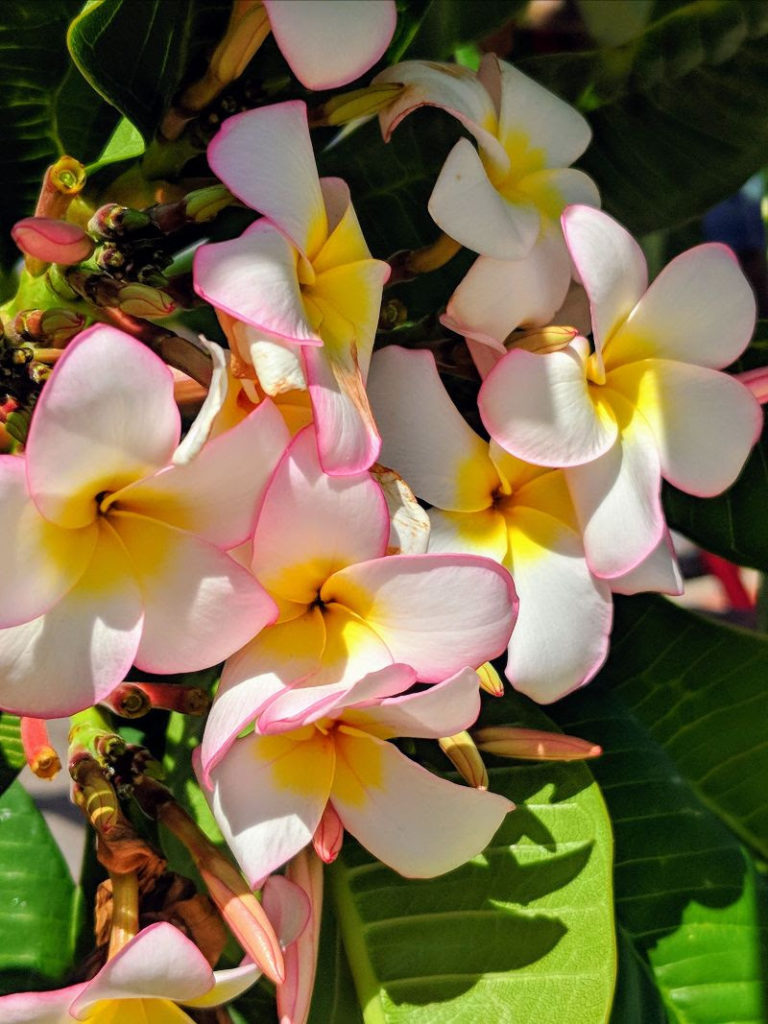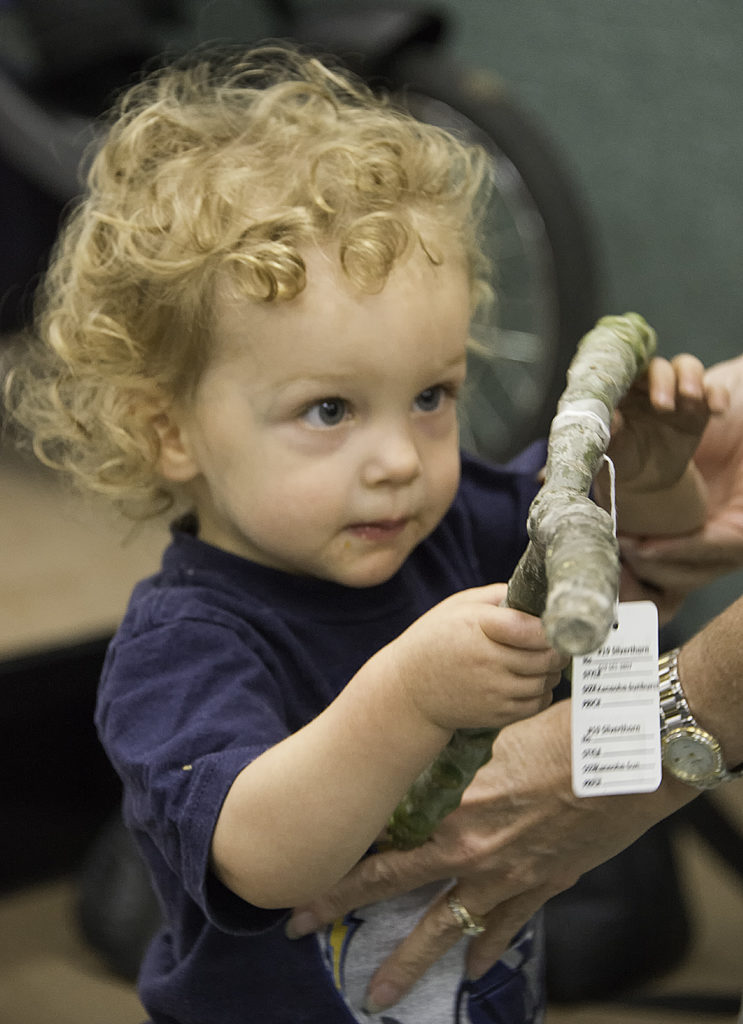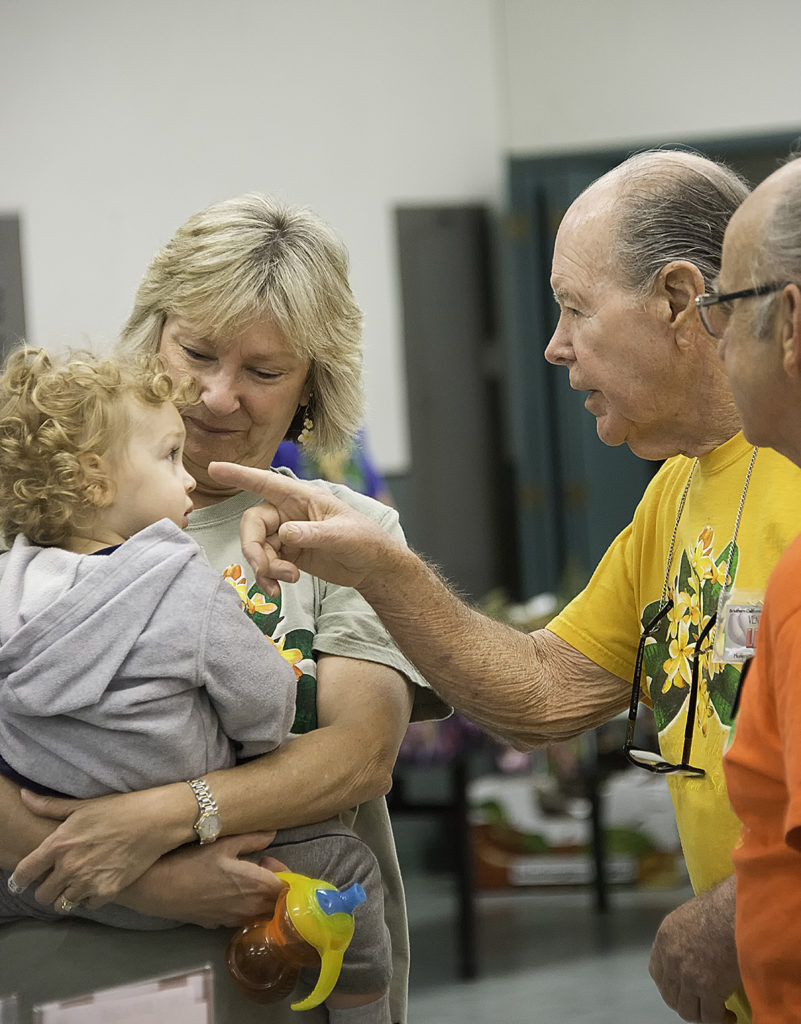Remembering Greg Silverthorn
by Mike Atkinson

What a void Greg Silverthorn’s passing leaves in our club. His smile and verve for life could light up the darkest night. His generous, kind spirit touched more people than can be counted. I am blessed to have been one of them.
I always suspected that our club leadership strategically placed Greg right inside the entrance to our sales. What better way to put people at ease and bring a smile to their face than seeing his face greet them? His plants and cuttings were always of exquisite quality, but it was his spirit that stayed with those who met him. He was so generous with his extensive knowledge growing plumerias.
Greg and MaryAnn married 51 years last March. It wasn’t long until they were visiting Hawaii and bringing sticks back with them to try growing. Then they were offered a 30-year-old plumeria tree in Pacific Beach. Greg and Aaron took 250 cuttings and moved the tree to their property in Lakeside. They discovered the Society when trying to find where to sell the cuttings.
Greg shared with us many amazing cultivars the family discovered in Hawaii over the years, which are now adorning gardens all over Southern California: Silver’s Cranberry, Silver’s North Shore, Silver’s Pink Shadow, and Silver’s Moonlight, to name just a few. He also named for his granddaughters two seedlings he grew: Rori and Paige (who we know well as their amazing helpers at so many sales.) He grew and developed all these and so many other named plumerias, with ultimately 140 different cultivars planted on their property on the hill.

I’ll never forget one of the few workshops he led in a meeting a few years ago with his son Aaron. He talked about the importance of growing plumerias by feeding the soil with important natural, organic nutrients to help them thrive, which started me on a journey of learning more about organic gardening. I remember so well that the folks who attended the meeting were captivated at his valuable information and thankful for sharing his wise growing insights.
Greg is survived by his wife, MaryAnn, and son Aaron and his son Ian (the youngest member in Society history), and daughter Shauna, husband Bernie, their son Beau and daughters Rori and Paige. They all express their deep appreciation for their plumeria friends and club members who have been so supportive. They hope to make it to future meetings to see us all.


An Interview with Greg, Mary Ann, and Aaron Silverthorn
By Kim Schultz – first published in Plumeria World June 2011
If you’ve been to our cutting sales on crazy, busy Saturday, you have seen Greg, Mary Ann and Aaron manning the demonstration table. If you’ve been to our plant sales, the Silverthorns are usually the first people to your left selling plants when you enter the room. I love homes where dogs greet me in the driveway, and the Silverthorn family has two German Shepherds named Lena and Kane (the Hawaiian word for “man”) to do the greeting honors.
Greg and Mary Ann have lived on top of a hill in Lakeside with a gorgeous view for twenty years; they have enough land that their son Aaron lives in his own house right next door. They are third- and fourth-generation native San Diegans. Greg and Mary Ann were both students at St. John of the Cross, but they first met at the Carmen Rand Swim Club in 1965. Greg was apparently thinking of becoming a priest until he saw Mary Ann in a black and white polka dot bikini; after forty-one years of marriage later, he’s still talking about that bikini. They have two children, Aaron and his older sister, Shauna, and two granddaughters, Paige and Rori, with a grandson on the way in October.
They are a multi-talented family, to say the least. Among Greg’s many past occupations, Greg and Aaron built houses together. I saw both a fish/cheese/meat smoker and a goat-milking station that Aaron saw photos of online then figured out how to build. Mary Ann retired after twenty-six years as a financial analyst for EDS; Greg is a teacher with JCCS, Juvenile Court and Community Schools, teaching fourteen- through nineteen-year-olds. Aaron is currently studying to be a teacher that helps the same population with skills and job training.
Since I had a four-year-old in tow, our first stop was not the plumeria but the pen with two goats and fourteen chickens so we could see the animals. The chickens lay beautiful green eggs, and the goats have just started giving milk. All the animal droppings are used for their own compost, along with equestrian compost. Local stables have to pay for disposal costs if they do not compost their wastes, but they can dispose of them for free if they compost, so most places offer free compost by the truckful to anyone who asks.
The Silverthorns now have eighty varieties of plumeria and more than three hundred plants in their nursery. They do not have a greenhouse, so all their plants are rooted and raised outside: “If it can’t live on its own,” Greg said, “I’m not growing it.” All their plants come from their own mother plants; they don’t do seeds or seedlings.
What struck me as unusual about the Silverthorne’s collection is how beautiful every plant was, even without blooms. Every tree had gorgeous symmetrical branches, perfectly proportioned for the overall size of the tree. Even the cuttings were great shapes; they were going to be beautiful trees. “Oh, there’s a pile over there of rejects,” Aaron showed me. “Every year, [Greg] goes through and rejects the ones that don’t look good, cuttings and rooted plants alike.” Sure enough, there was a pile of mushy plumeria.
Their plumeria collection began with some cuttings from Hawaii and the Del Mar fair. They’ve had four or five for twenty years. Since then, it’s grown by collecting in Hawaii. They tour the gardens with a groundkeeper and always ask for permission to take any cuttings. The groundskeepers are happy to share. They’ve visited botanical gardens on each of the islands, including the Polynesian Cultural Center (Aaron has a friend who got him in) and the Kauai Botanical Gardens, where they got a Kauai Beauty, similar to Hilo Beauty but with more variegation in the leaves. Mary Ann thinks timing their vacations to Hawaii between March and May makes people more likely to share cuttings.
Greg was the first to get hooked on plumeria, while Aaron specialized in fruit trees. He shared some delicious little apple bananas off his trees. Aaron took an organic gardening class at Cuyamaca College, then an ornamental horticulture class, then began researching on the internet about organic gardening. He got a water- and soil-testing kit, and noted that the salt content of their water was 1200 parts per million (ppm). He realized all the time-release fertilizer granules they were using added salt to the plants. “Salt acts on plants like it acts on people,” Aaron said. “It absorbs and then drains all fluid.” To minimize the effect of salt on their plants, they began using completely organic compost and installed a 5300-gallon gravity-fed cistern that collects all the water off the roof. They use that water to flush the plants once a week. They need 2 inches of rain to fill the cistern. Now the salt content Aaron finds is 400 ppm, and the plants are thriving.
Like many of us, the Silverthorns have heavy clay soil. They’ve come up with an ingenious solution. They’ve built retaining walls next to their house to utilize the clay and take advantage of their slope. The top layer in those beds is compost and topsoil; the heavier clay remains at the bottom. The plants send out roots into the top layer to collect nutrients; the long roots run into the clay, which retains water and helps keep the plants hydrated. Since the compost is actually alive, it keeps the ground warm in the winter. They’ve gone out on cold days, turned the compost around the base of the plants, and seen steam rising from the ground. When Greg built the house, he planted over a hundred eucalyptus trees, thinking they would grow and be firewood for the rest of his life. Unfortunately, due to a septic issue, the eucalyptus trees have become mulch for life.
Their mother plumeria plants are planted in the ground and are huge. Their smaller-sized plants (1-gallon, 2-gallon, and so on) are placed next to their mother plants in the compost. That way, they start to send roots out to the rich compost. The plants develop amazing roots. The mother plants all have cages to prevent damage from the chickens and rabbits.
They joined the Society after they saw a piece on television about one of the sales. They began selling after they obtained cuttings from a tricolor plumeria from a house they were working on. The Silverthorns sell at our plant sales in the fall, and they have some huge plants to sell this year.
What is their favorite plumeria? Greg and Mary Ann like Penang Peach, Kimo, and Kauai Beauty, but they picked Paul Weissich. They showed me a six-to-eight foot tree that they had bought originally from Doug Jones years ago. When they bought it, it looked like a yellow, more like an Aztec Gold. After a couple years, the tree put out bright orange blooms, which were striking but not what they remembered. Finally, they called Doug (not to complain, since they loved the color, but out of curiosity) and Doug said the color depends on the climate. Doug is on the coast; the Silverthorns are inland, so they enjoy the vivid orange blooms.